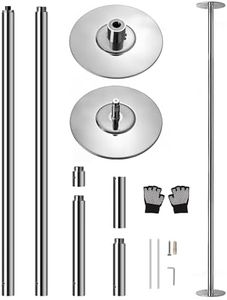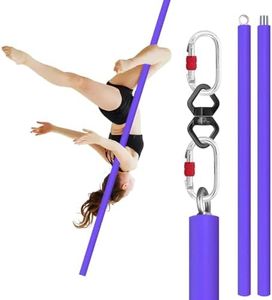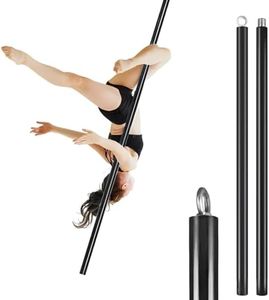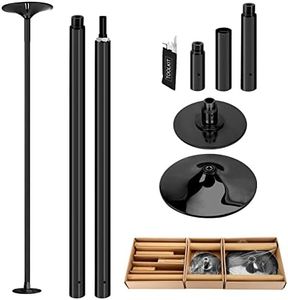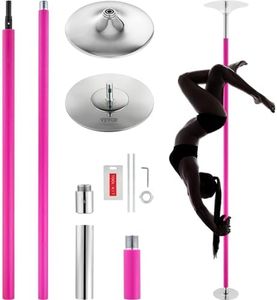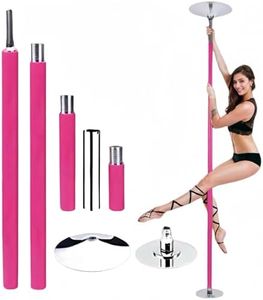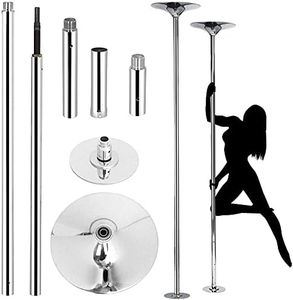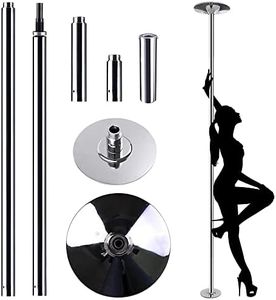We Use CookiesWe use cookies to enhance the security, performance,
functionality and for analytical and promotional activities. By continuing to browse this site you
are agreeing to our privacy policy
10 Best Portable Dance Pole
From leading brands and best sellers available on the web.Buying Guide for the Best Portable Dance Pole
Choosing a portable dance pole is all about finding a sturdy, safe, and easy-to-install pole that matches your skill level and intended use. Whether you want it for fitness, dance practice, or fun, it’s important to consider how much space you have, how portable you need it to be, and what type of moves (static, spinning, tricks) you plan to perform. Understanding the key specifications helps ensure the pole you choose will be supportive, easy to use, and fit seamlessly into your environment.Pole DiameterPole diameter refers to the thickness of the pole and is important because it affects grip comfort and the types of tricks you can perform. Common diameters are around 40mm, 45mm, and 50mm. Thinner poles (like 40mm) are easier to grip, especially for people with smaller hands, and are good for spins and climbs. Standard diameter (45mm) is widely used in competitions and suits most hand sizes for general use. Thicker poles (50mm) are traditional and can increase grip challenge, making them more suited for those with larger hands or advanced users. Think about your hand size and what feels comfortable, as well as whether you want to train for competitions.
Pole MaterialThe material of a portable dance pole affects grip, durability, and maintenance. Chrome, stainless steel, and brass are popular options. Chrome is affordable and widely available, offering medium grip and suiting most users. Stainless steel has a smoother surface and is great for those with allergies, but it can feel slippery, especially if your hands sweat. Brass is highly grippy, even with sweaty hands, making it good for advanced tricks in humid climates. Choose based on your grip preference, climate, and any potential allergies.
Static and Spinning ModesSome dance poles are static only, while others offer both static and spinning modes. Static poles don’t rotate, which can make learning basic spins and holds easier. Spinning mode allows the pole to rotate, enabling advanced moves and fluid routines. Many users enjoy poles that offer both options so they can train a variety of moves as their skills improve. Think about your current skill level and future goals: beginners may start with static but may appreciate the option to switch to spinning as they progress.
Adjustable HeightAdjustable height allows the pole to fit different ceiling heights and spaces. Most portable poles can be extended within a certain range. Check the minimum and maximum height to ensure it matches your ceiling at home or anywhere you plan to use it. If you want to use it in multiple locations, more adjustability is helpful.
Portability and AssemblyEase of assembly and portability determine how often you’ll actually want to set up and use your pole. Some poles are designed for quick installation without drilling, using pressure mounting systems. Check how many parts the pole breaks into, how heavy it is, and if there’s a carrying case. If you plan to move the pole often or don’t want to leave it set up, look for models designed for tool-free setup and easy transport.
Weight CapacityWeight capacity tells you how much load the pole can handle safely. Higher capacities mean the pole can support heavier users or more forceful moves, such as pulls and flips. Make sure the capacity covers your body weight plus extra if you plan on athletic tricks or use by multiple people. This ensures both safety and durability.
Ceiling CompatibilitySome portable dance poles are designed specifically for flat ceilings, while others have accessories for sloped or uneven ceilings. Knowing your ceiling type is important to ensure the pole can be installed securely and safely. Check if the pole offers the necessary mounts or extensions for your specific ceiling.
